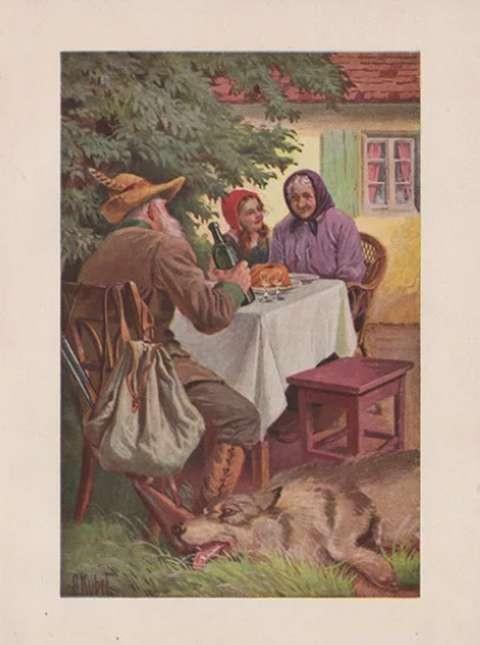Otto Kubel illustrated numerous books and his work was frequently republished in different editions. Despite his productivity, it's pretty hard to get originals and information about specific items. Two world wars and a stain on his legacy, thanks to his membership in the Nazi party, didn't help.
Well, we got scans of four illustrations of Red Riding Hood, illustrated by Otto Kubel, and unreliable data they were published around 1900. Considering his other work in that area, I believe 1920 would be a much better approximation.
We don't know:
- If these illustrations belong to a stand-alone edition (without other fairy tales) of the book.
- If these four illustrations were the only ones in the edition in question.
But we know in 1930 Uvachrom published a series of six postcards with scenes from Red Riding Hood, pictured by Kubel. Six was a standard number for such series and four of the illustrations below were used for picture postcards. This means two are missing from our little collection on this page or two more were done by the artist.
As we already mentioned the word 'little' - is better to say Red Riding Hood or Little Red Riding Hood? A bit of digging through literary history gives us a chance to identify two dominant versions of the same tale. One is French (by Charles Perrault) and the other is German (by Jakob and Wilhelm Grimm). None of them uses the word 'little' which mainly became part of the title after translations in English and other languages.
This was just for intermezzo. This fairy tale is so rich with history, symbolism, and ways of interpretation, you should also read this article about Red Riding Hood' symbols. Don't forget to come back!
All right, let's look at the illustrations now:

Red Riding Hood (Red Cap would be a better translation) is leaving home. She has to visit her granny who is ill. She'll bring her some goods and keep her company for a while. Granny lives in the woods and is a bit lonely. Her mother obviously warns her about the path, which is clearly depicted in the illustration.

We don't know what mother told her, because we got just pictures and no accompanying text. It could be not to talk to strangers (that would be a French version), not to stray from the path (most popular German version), or something else.
However, Red Riding Hood is clearly wasting her time by picking flowers. If she intends to reach her grandmother who is hungry, sick, and lonely, she is not focused enough. By bringing some flowers she would probably bring some cheer into granny's home yet her presence would definitely be much more appreciated.

And here we are. Red Riding Hood with flowers standing in front of her grandmother's bed. Only there is no grandmother. While she was picking flowers, the wolf ate her granny and changed into her nightgown.
Red Riding Hood is surprised. Her grandmother looks so different. Her voice is strange and ... We already know how probably the most famous dialogue in the history of fairy tales goes, don't we?

This is the ending scene of the story. The girl's mother is missing (so is true for her father, who is conveniently replaced by the hunter) but all other characters are there.
The hunter killed the wolf and saved both of his victims. Granny doesn't look very ill and Red Riding Hood has even more reddish cheeks than before. Maybe because half of the bottle is already empty?
We'll never know. Yet something is clear - we are dealing with one of the best fairy tales ever written. It doesn't matter if you look at it from a folklorist's, a symbolist's, a historian's, or any angle, you'll always find more and more levels for the interpretation.
If you would like to go through the story once again, this time with additional two illustrations, visit Red Riding Hood postcards by Otto Kubel.